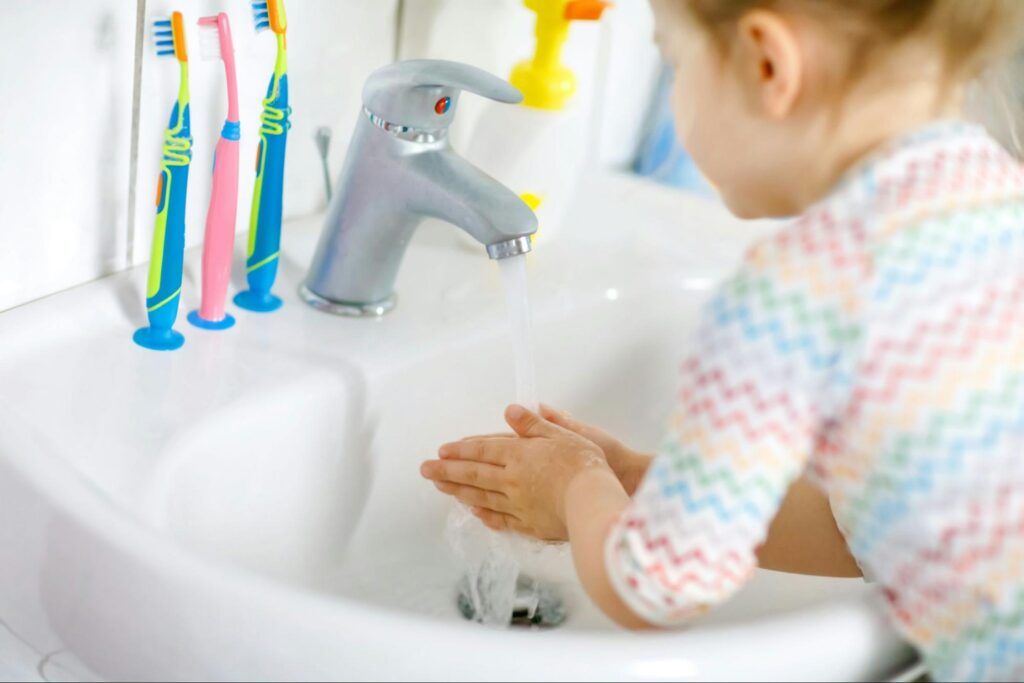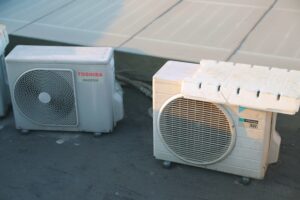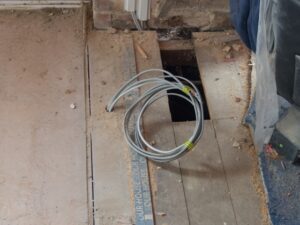Have you ever experienced the frustration of a backed-up drain?
It can be a real headache, whether it’s a slow drain in your kitchen sink or a full-on backup in your bathroom. But what causes drains to back up in the first place?
Is it just a simple clog, or could there be a bigger issue at play?
Let’s break down the common causes of drain backups so you can better understand what’s happening—and what you can do about it.
One of the most common causes is blocked pipes. Over time, debris, grease, or even tree roots can find their way into your pipes and create blockages. When this happens, water backs up into your sinks, showers, or even your yard.
Another frequent culprit is an overwhelmed drainage system, especially during heavy rainfall. Your pipes or sump pump might not be able to handle the volume of water, leading to backups. If your sump pump isn’t working properly, it’s like trying to hold back a flood with a leaky bucket.
Understanding the root cause of the issue is the first step toward finding a solution. Whether it’s a simple clog or a more complex drainage problem, addressing the issue quickly can save you from costly repairs and more frustration down the line.
Excel Mechanical specializes in diagnosing and solving these problems efficiently, ensuring your plumbing system runs smoothly.
In this blog, we will discuss:
- Common causes of drain backups and how they affect your plumbing.
- How weather and structural issues can contribute to drainage problems.
- Solutions and maintenance practices that will help you prevent backups in the future.
Let’s break it down!
Common Causes of Drain Backups
Drain backups can disrupt your life and cause significant damage if not addressed promptly.
Common causes include clogs from solid waste materials and tree roots intruding into sewer lines. Grease in kitchen sinks and non-disposable items flushed down toilets also contribute to the problem.
Understanding these causes can help in effectively managing and preventing drain backups.
Clogs from Solid Wastes
Solid waste clogs are a frequent cause of drain backups. These occur when materials like hair, food particles, and soap scum accumulate in pipes. This buildup reduces water flow and can eventually lead to complete blockage.
You can prevent these clogs by using drain screens to catch debris. Regular cleaning with hot water and a mild detergent can help clear your pipes. Avoid putting fibrous scraps or large food remnants down the sink.
If you encounter persistent issues, professional assistance can help resolve deeper clogs.
Tree Root Intrusions in Sewer Lines
Tree roots can cause significant damage to sewer lines. They naturally seek moisture and may grow into small cracks in your pipes. Over time, this growth can obstruct water flow and cause backups.
Slow drains and frequent clogs are signs of tree root intrusion, which requires early detection.
Regular inspection and maintenance of your sewer lines can prevent costly repairs. Mechanical root removal or trenchless technologies can help clear obstructions without damaging your yard.
Grease Buildup in Kitchen Drains
Grease buildup is another common cause of drain backups, especially in kitchen sinks. Fats, oils, and grease can solidify in pipes, narrowing passages and reducing flow.
To prevent this, avoid disposing of grease down the sink. Instead, collect it in a container and dispose of it properly. Regularly flushing your drains with hot water can help dissolve minor grease accumulations.
If you suspect serious buildup, professional services can provide thorough cleaning.
Flushed Non-Disposable Items
Flushing non-disposable items can lead to serious blockages in your plumbing system. Items like wipes, sanitary products, and diapers do not break down easily and can cause severe clogs.
To prevent backups, only flush toilet paper and human waste. Educate your household members on proper flushing habits. If a blockage occurs, avoid using chemical drain cleaners, which may damage your pipes.
Consider professional help to remove the obstruction and protect your plumbing infrastructure long-term safely.
The Impact of Weather on Drainage Systems
Weather plays a crucial role in how well your drainage system performs. Two main weather factors that can affect drainage are heavy rain, which can cause flooding, and cold conditions, which can lead to issues with freezing pipes.
Heavy Rain and Flooding
During heavy rain, your drainage system may struggle to handle the excess water. This can lead to backups and potential water damage in your basement.
Blocked pipes and overwhelmed systems can worsen these issues, making maintenance important. If your area regularly experiences heavy rain, consider installing a sump pump for extra protection. A properly maintained sump pump helps divert water from your home, reducing the risk of flooding.
If you notice repeated problems, it may be time to examine updates to your system.
Effects of Cold Weather and Snow
Cold weather poses different challenges for drainage systems.
When temperatures drop, water in pipes can freeze, causing blockages. These blockages may lead to backups or even burst pipes, resulting in expensive repairs. One way to prevent these issues is by ensuring proper insulation around your pipes, particularly in unheated areas like basements and attics.
If snow accumulates around your home, it can also block drainage paths. Clearing snow away from critical areas helps water flow freely once it melts. For long-term peace of mind, turning to experts ensures your plumbing and HVAC systems are equipped to handle these cold conditions effectively.
Our team offers tailored solutions to maintain functionality and prevent costly damage.
Structural Problems Leading to Backups
When dealing with drain backups, structural issues often play a significant role. Problems such as aging pipes and poor system design can disrupt the flow and lead to severe blockages.
Aging and Collapsed Pipes
Over time, pipes can degrade due to weakening materials like cast iron or clay. As these pipes age, they become more prone to cracks and breaks, which can lead to partial or full collapses.
These collapses restrict water flow and cause backups. You might notice frequent clogs or slow draining as warning signs. It’s crucial to address these problems promptly to prevent water damage and major repair costs.
Replacing old pipes with modern, durable materials can be a long-term solution.
Poor Drainage System Design
A poorly designed drainage system can lead to recurring issues. Incorrectly sized pipes or improper slopes hinder effective water drainage.
When water can’t flow smoothly, backups are common, especially during heavy rains. It’s vital to ensure your system is designed to handle expected water volumes.
Consulting with experts like Excel Mechanical, who understand the intricacies of effective drainage in residential and commercial settings, can help you optimize your system. Our team offers tailored solutions to ensure your drainage fits your needs and budget.
Role of Maintenance in Preventing Drain Backups
Regular maintenance is crucial in ensuring that your drains remain free of blockages and operate efficiently. Focusing on cleaning, inspection, and proper waste disposal can significantly reduce the risk of drain backups.
Regular Cleaning and Inspection
Frequent cleaning of your drains helps prevent clogs and buildup. Use natural solutions, like baking soda and vinegar, to keep pipes clear without damaging them. Monthly checks are a good routine to follow, ensuring your drainage system is functioning well.
Inspections identify early signs of potential issues. Look for slow-draining water or unpleasant odors, indicating a developing problem. Professional inspections by experts ensure a more thorough and accurate assessment.
Our skilled technicians are knowledgeable in pinpointing issues before they escalate into major problems.
Proper Waste Disposal Practices
Dispose of waste correctly to maintain healthy drains. Avoid pouring grease or oil down the sink, which can harden and create major blockages. Sink strainers catch debris and food particles, which can contribute to clogs.
Dispose of non-disposable items, like wipes and large food scraps, in the trash instead of the toilet or sink. Educate household members on what can and cannot be flushed or washed away.
Adopting these practices is a simple way to extend the life of your drainage system and prevent backups.
Diagnosing Drain Backups
Understanding why your drains are backing up is crucial.
Early detection and accurate diagnosis can prevent extensive damage and costly repairs. This involves recognizing warning signs and considering when to consult professionals with specialized tools.
Professional Assessment and Tools
When DIY methods don’t work, professional help is often necessary.
Plumbers use tools like cameras to inspect pipes and pinpoint blockages or damages. These tools offer a clear view, helping identify issues like tree root intrusion or collapsed pipes.
Skilled technicians can accurately assess your system’s health and determine the source of backups.
Signs and Symptoms of Backup Issues
Several indicators suggest your drains are backing up.
Watch for slow-draining water in sinks or tubs, gurgling pipe noises, and unpleasant odors. These are often early signs of a developing problem. In some cases, water might visibly back up through drains during use.
Addressing these issues promptly can prevent severe damage, especially in areas prone to heavy rain where systems get overwhelmed. Regular maintenance and early intervention are key.
Solutions and Repairs for Drain Backups
Addressing drain backups involves identifying the cause and taking appropriate actions. This may include clearing clogs, repairing or replacing pipes, and upgrading drainage components. Each solution targets specific issues, ensuring effective and long-lasting results.
Methods for Clearing Clogs
Clogs are a common reason for drain backups.
- To clear them, begin with a plunger, which can often resolve minor blockages in sinks and toilets. Ensure a tight seal around the drain for the best results.
- A drain snake or auger can be more effective for tougher clogs. These tools reach deeper into pipes and break apart obstructive debris.
- Insert the auger carefully, slowly turning it to catch and remove the clog.
- Chemical drain cleaners are another option but should be used sparingly due to potential pipe damage.
- Always follow the manufacturer’s instructions when using these products.
Repairing or Replacing Damaged Pipes
If a clog isn’t the issue, damaged pipes might be. Cracked or corroded pipes can lead to backups and leaks. Inspect your pipes for visible damage, rust, leaks, and structural problems.
Applying pipe patches or sealant may temporarily fix the problem when damage is minor. Replacing the affected pipe section is the most reliable solution for extensive damage. This task often requires professional assistance to ensure proper installation.
Upgrading Drainage System Components
Older drainage components may not be able to handle increased demand or heavy rains, causing backups. Upgrading components like sump pumps and drain tiles can improve system efficiency. Consider these upgrades if you experience frequent drainage issues.
Installing a modern sump pump can prevent water accumulation in your basement. Ensure it’s powerful enough for your home’s size. Drain tiles can redirect water away from your foundation, reducing backup risks.
Preventative Practices for Homeowners
It’s important to follow certain practices to avoid drain backups. Proper drain use, installing backwater valves, and strategic landscaping can greatly reduce the risk of issues.
Best Practices for Drain Use
Proper use of your drains can prevent clogs and backups. Avoid disposing of grease, large food particles, or fibrous substances down the kitchen sink. Bathrooms also need attention; use strainers to catch hair and soap scum.
Regular cleaning with natural solutions like baking soda and vinegar can help maintain clear drains. Remember to run hot water through your drains weekly to clear minor blockages.
Educating family members about these habits can make a big difference in long-term maintenance.
Installing Backwater Valves
Backwater valves are an effective tool for preventing sewer backups during heavy rain.
They are installed in your home’s sewer line and automatically close when water starts flowing backward. Thus, they offer a protective measure against basement flooding.
Consult a professional plumber to assess your home’s needs and ensure proper installation. Excel Mechanical excels in providing reliable plumbing solutions and can advise on the best backwater valve for your home.
Rely on expert advice to keep your home protected.
Landscaping to Minimize Root Intrusion
Tree roots can invade and block underground pipes, leading to serious drainage issues.
You can minimize this by strategically planning your landscaping. Avoid planting trees with aggressive root systems near sewer lines. If trees already exist, consider regular inspections and maintenance.
Use barriers like metal or plastic to redirect roots away from pipes. Regularly check for signs of slow drains, which may indicate root intrusion. For comprehensive assistance, rely on Excel Mechanical for expert guidance and service.
Protect your yard and plumbing by preventing root-related problems.
Frequently Asked Questions
Dealing with drain backups can be stressful, but understanding the reasons behind them and knowing how to fix the issues can save you time, money, and frustration. Let’s dive into some common questions to help you troubleshoot and prevent drain backups in your home.
What are the common reasons for household drain blockages?
Household drain blockages often occur due to accumulated debris, such as hair, soap, grease, or food particles. Tree roots might invade pipes, and outdated plumbing systems can also contribute to problems.
How can a sewer backup be remedied?
You can remedy a sewer backup using a plunger or drain snake to clear clogs. For more serious issues, you might need to call professionals for hydrojetting or pipe repairs to ensure proper drainage.
What are the homeowner’s responsibilities when a sewer backup occurs?
As a homeowner, you must maintain your property’s plumbing system. This includes checking for signs of clogs and taking action when blockages occur. Regular cleaning and maintenance can prevent backups.
Can multiple clogged drains indicate a larger underlying issue?
Yes, multiple clogged drains often signal a larger plumbing issue. This could be a main sewer line blockage or septic system failure, requiring immediate attention to prevent significant damage.
What are the health and safety concerns of staying home after a sewage backup?
Staying in a home after a sewage backup can expose you to harmful pathogens, leading to illnesses. It’s essential to clean and disinfect affected areas promptly to ensure safety.
What steps can prevent future sewage backups, especially after rainfall?
Preventing future sewage backups involves regular inspection and maintenance of your plumbing system. Installing backwater valves and sump pumps can protect against heavy rainfall. Consult with experts like Excel Mechanical to ensure your systems are robust and suited to your needs.




